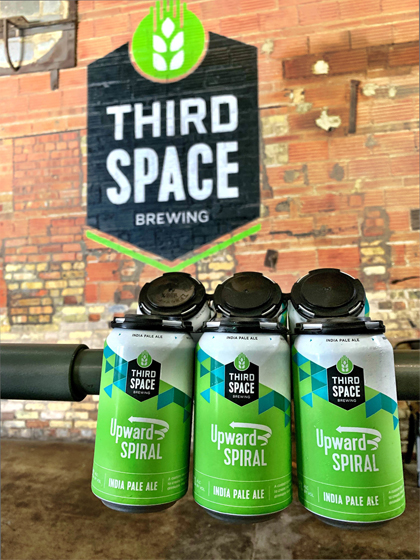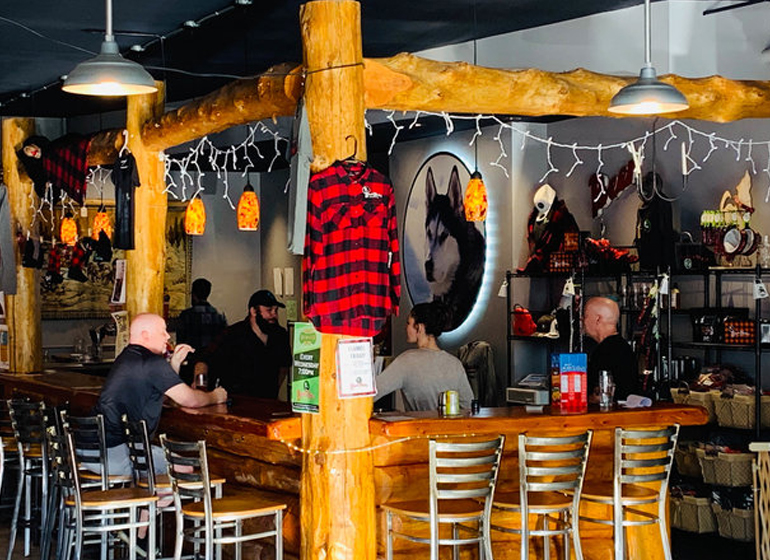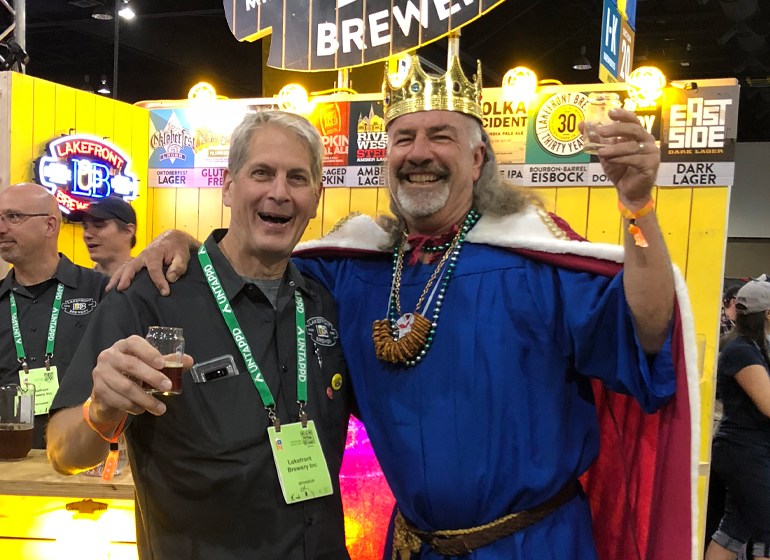The last time Chalonda White visited Milwaukee for the sole purpose of drinking its beer, she could count the city’s breweries on one hand.
It was 2012 and the Brew City was home to the legacy beer giant Miller Brewing Co. that helped give the city that nickname and the three dedicated area breweries that emerged during the rebirth of local brewing in the 1980s and 1990s: Lakefront Brewery, Sprecher Brewing Co. and Milwaukee Brewing Co.
Seven years later, on a Saturday in late May, White – a Chicago-based beer enthusiast who blogs, as Afro Beer Chick, about her beer adventures and founded a Chicago chapter of a national organization for fellow female beer fans – decided to return to Milwaukee to check out its now-robust craft beer scene.
The day before her trip, she put a call out on Twitter soliciting recommendations from locals, who were eager to help her navigate the city’s landscape, now 40 breweries strong. Heeding their recommendations, White’s daytrip included brunching at Comet Café and sampling a limited-release Jam Sesh PB&J Ale at Eagle Park Brewing Co. on the East Side, picking up a six-pack of Upward Spiral from Third Space Brewing in the Menomonee Valley, relaxing at the Milwaukee Yacht Club on the lakefront, trying an assortment of IPAs and stouts at 1840 Brewing Co. in Bay View and taking in the woodsy aesthetic of Black Husky Brewing’s Riverwest taproom.
Her review?
“I had a freaking ball,” White said. “It really changed my view of Milwaukee, with how much it’s developed downtown, Riverwest, the lakefront. It gave me a higher respect for Milwaukee and a whole new set of eyes. This town is pretty dope.”
Mapping Milwaukee’s beer scene
For the city that was built in part by 19th century beer barons, beer today remains a driver of out-of-town traffic to Milwaukee.
While data isn’t available showing its direct economic impact on metro Milwaukee, travel and tourism research firm Longwoods International indicates beer tourism was responsible for 11% of total overnight trips in Milwaukee in 2018, compared to the national average of 5%. Breweries were among the top five reasons for visitors to spend an overnight in Milwaukee, according to the research.
In 2018, visitors to Milwaukee spent $483.2 million on food and beverages in Milwaukee County, an increase of 6% over the previous year, according to VISIT Milwaukee. It was the second-highest visitor spending category last year, behind local transportation.
VISIT Milwaukee has made a marketing push in recent years to leverage the city’s historic beer roots, while promoting the wave of new microbreweries, in an effort to capture the growing “brewcation” market. In some ways, it’s a matter of leaning in to what has always been core to Milwaukee’s identity.
“Milwaukee has always had a strong beer scene,” said Megan Suardini, vice president of marketing and communications for VISIT Milwaukee. “As far as beer tourism, we are very well known as ‘Brew City’ across the nation, which obviously goes back to the beer barons, Pabst, Schlitz and Blatz. There isn’t any confusion that Milwaukee is known as a hot beer scene.”
When it comes to competition, the cities that have effectively positioned themselves as beer tourism destinations are largely outside of the Midwest, including Denver, San Diego, Portland and Asheville, North Carolina, Suardini said. Closer to home, Madison, Minneapolis, St. Paul and Grand Rapids, Michigan all have “strong beer scenes,” though Suardini wouldn’t call them competitors.
Milwaukee has a unique position in the market, however, she said.
“They all have strong craft beer scenes, but we have a very strong craft beer scene along with the beer history and beer culture,” she said.
In 2018, VISIT Milwaukee partnered with the Milwaukee Craft Brewery League, Lakefront Brewery, Pabst Brewery and malt company Malteurop Malting Co., which has a factory in Milwaukee, to release The Original Brew City Beer Map, a foldable guide of 62 beer-related destinations in the greater Milwaukee area, including the metro area’s many beer gardens, historic beer sites and breweries.
“It was a project a few years in the making,” Suardini said. “What really makes it unique is it’s all inclusive; it doesn’t just represent breweries, but all beer-related attractions. Every other city that I can think of that has a beer map or beer trail, it’s very much focused on breweries exclusively. We worked hard to include a combination of breweries and all other beer-themed activities you can do.”
VISIT Milwaukee printed a half-million copies to distribute both in-market – at restaurants, hotels and breweries – and out-of-market at rest stops and other high-traffic tourist areas. The organization is also in talks with its counterpart in Madison to explore collaborating on a piece that would draw the connections between the two strong beer cities.
Led by VISIT Milwaukee, a delegation of beer representatives brought the then freshly-released map with them in summer 2018 when they attended the Great American Beer Festival, a three-day annual event in Denver that draws more than 60,000 beer enthusiasts from around the world. It’s a strategic place for Milwaukee representatives to be. Among GABF attendees – more of half of whom come from outside of Colorado – 84% reported being interested in traveling for beer-related reasons.
“It’s very much the market we’re trying to get to,” Suardini said.
In a crowd of more than 2,220 breweries hailing from every state, the Milwaukee group had to set itself apart. From its station, Third Space distributed samples of its popular Happy Place pale ale. VISIT representatives distributed maps and encouraged attendees to sign up for a chance to win the “ultimate brewcation” experience in Milwaukee, which netted more than 400 responses. A costumed Jim Haertel, president of Best Place at the Historic Pabst Brewery, offered passersby a chance to take a photo with legendary beer icon King Gambrinus. The stunt helped boost Milwaukee’s visibility.
“Everyone wanted a picture with the king,” Haertel said. “I must have taken over 3,000 pictures over the three days.”
Beer tours
With the gesticulations of someone trained in theater, Jason Nykiel slips in a few innuendos as he explains the beer brewing process to a group of about 25 people encircling him at Lakefront Brewery.
Using a tinge of edgy humor to liven up an otherwise informative beer history presentation has become a hallmark of Lakefront Brewery tours, which regularly rank among the most popular in the city. While Lakefront tour guides – many of whom boast theater, improv and other public speaking backgrounds – have the freedom to develop their own script and add their own flare to the tour, they are encouraged to keep hospitality top of mind.
“I tell them, ‘You are ambassadors for the city,’” said Russ Klisch, president and co-founder of Lakefront Brewery. “I say, ‘You can’t say anything bad about anyone else’s sports team. You want to make sure that person is feeling very comfortable in the city and happy to be here and wants to come back. You are going to be one of the few people that (visitors) actually interact with in the city. And the image you present to people is what they’re going to be leaving with of Milwaukee.’”
When the 32-year-old brewery first began offering tours in its early days, Klisch would deliver them “like a science teacher.” His brother, brewery co-founder Jim Klisch, meanwhile, won visitors over by handing out beer at the tour’s outset and weaving humor into his presentation.
“Everybody took his tour; no one wanted mine,” Russ said. “We found out early on that people come on tours for two reasons: they want to be entertained and they want to drink beer.”
Lakefront has been sticking to that formula since. Over the past 20 years, the brewery has seen a “tenfold” increase in the number of people walking through its doors, and the reason behind tourists’ visits has also evolved over the years, Russ said.
“It used to be that people would say ‘I’m coming for a wedding or for work,’” Russ said.
“We used to get that all the time. But now we see people actually coming to visit because they think it’s a destination.”
By his estimate, about half of tour-goers are from out of the state and another 25 percent are from a Wisconsin city other than Milwaukee.
Russ said Lakefront offers a quintessential Milwaukee experience, with its cream city brick walls, industrial feel, proximity to the Milwaukee River, Friday night fish fries and, of course, beer.
It represents one prong of what he calls Milwaukee’s “brewery trifecta.”
“We have heritage breweries like Miller and the Pabst complex and Schlitz complex for beer history nerds to visit,” he said. “We have Sprecher, ourselves and Milwaukee Brewing Co. And then the new wave of craft breweries. Our city has all three. We have a lot of heritage and history and creativity that goes on with the breweries in town here. It’s a great destination for people from out of town to come here to drink beer in Brew City again.”
Among some of the city’s biggest beer champions is a sense of optimism for the city’s future.
“People from all over the country, when they’ve thought of Milwaukee, they think of the flyover city, the Rust Belt, the manufacturing; what’s really there to see in Milwaukee?” Haertel said. “But a lot of people are learning that Milwaukee is not just another city. We’ve saved so much of our history and our architecture and so much of it is interwoven with beer here in Milwaukee.”
Given Milwaukee’s relatively late start to the renaissance of craft brewing, some argue the city has catching up to do.
“As a whole, the growth that the craft beer scene in Milwaukee has seen over the past three years is definitely impressive. Yet when looking at similarly sized cities around the country, we are still far behind in a lot of ways,” said Jake Schinker, owner and chief creative officer of Eagle Park Brewing. “That being said, beer tourism to Milwaukee has seen major growth due to the larger variety of beer styles being offered and Milwaukee becoming a more popular travel destination as a whole due to things like our successful sports teams and growing culinary scene.”
Beer history
The steady flow of tourists streaming through the former Pabst Brewing Co. headquarters in downtown Milwaukee suggests the city’s historic beer roots also remain a draw.
The tour guides at Best Place at the Historic Pabst Brewery complex provide guests with beer and pretzels at its outset, before chronicling the history of Pabst, playing vintage beer commercials and walking visitors through the historic building’s Great Hall, Blue Ribbon Hall, Captain Pabst’s former office and the basement’s speakeasy. Haertel estimates about a third of visitors come from out of state, a third are local and a third come from elsewhere in Wisconsin.
In 2001, Haertel, a beer and history enthusiast, cashed in his 401(k) to purchase a trio of buildings in the historic brewery complex, which had then been shuttered for five years. He was compelled to preserve a major city landmark, not just for locals, but for visitors as well. One of the city’s biggest assets, he argues, is the preservation of its architecture.
On a recent afternoon, Haertel stood in the Great Hall as a tour of 14 people, including the tour’s youngest-ever participant, a 10-day-old baby, walked through the hall. He paused to tell the brief version of how he acquired the place.
“I heard they were thinking about tearing this building down,” he said. “Wouldn’t that have been a shame? And I thought people like you would want to come see the place and drink some beer and have some pretzels.”
On the southern edge of Waukesha County, Old World Wisconsin is looking to capture more beer history enthusiasts by building out its historic brewing demonstrations and adding a full-time operating brewery on its grounds.
Old World plans to build a complex at its entry that will include a reconstructed small brewery that will house the historic demonstrations, an early 20th century tavern and a permanent beer garden.
Dan Freas, director of Old World Wisconsin, sees the connection between the growing interest in craft brewing and its own historic brewing program. These days, people want to know what they’re consuming and how it’s made. Meanwhile, brewing is a big part of the state’s history that Old World hasn’t fully explored up until now.
“People are making travel plans around beer and visiting parts of the country and experiencing craft brews,” Freas said. “This is part of a strategy we’re using at Old World Wisconsin to diversify the experience and make sure we’re offering something for everyone … And certainly beer and brewing has proven already, in the short time we’ve been doing our program, to attract people who might not otherwise think about visiting us.”
An authentic experience
While “brewcation” has entered the tourist industry lexicon with the micro-brewing surge in recent years, Schinker said out-of-towners don’t typically travel exclusively to imbibe in its brews. But it does serve a key purpose for many travelers.
“I don’t think that most people are traveling for the sole reason of going to breweries, but rather go to a new city and use breweries as an easy way to see parts of town that aren’t just your boilerplate tourist destinations,” he said. “When people visit us from out of town we often get asked about other things to do around the city during their stay and are more than happy to give them the local’s guide to Milwaukee.”
Since opening in 2015, Eagle Park Brewing has received visitors from across the world, Schinker said. One recent evening, he spoke with a man who was in town from Portland, Oregon, and later a couple from Japan.
The fact that brewery owners like Schinker can be seen walking around and talking with customers is part of Milwaukee’s charm, Russ Klisch said.
“Especially with the small breweries, it’s not uncommon for an owner to be walking around or giving a tour,” Klisch said. “It’s not as polished. It’s not a PR push or advertisement that you might get other places. It’s more genuine.”
That’s a message Milwaukee can leverage, Suardini said. Drinking isn’t put on for tourists; it’s the city’s culture.
“Our whole city embraces it,” she said. “A trend right now is when you travel someplace, you want to feel like a local. You want to know the secret places. You want to have the inside scoop on the best restaurants; you want to know where the best bars are. So our locals are experiencing the same thing our visitors want to experience.”
When Milwaukee hosts the Democratic National Convention next summer, it will provide a unique opportunity for the city to show off its assets, among which many would count beer.
The convention is expected to spawn as many as 2,000 convention-related functions across the region. Lakefront is among the beer-centric venues preparing to host some of them.
“People coming for the DNC are going to be seeing a lot of the breweries here and it will be a great way to get the word out,” Klisch said.
Meanwhile, others have questioned whether it’s instead high time for Milwaukee to shed itself of its longstanding association with beer, brats and cheese; “Laverne & Shirley;” “Happy Days” and the Bronze Fonz.
VISIT Milwaukee won’t be leading that charge.
“Some people will say, ‘We’re more than beer and cheese,’ and what we like to say is ‘Yes, we have amazing beer and we have amazing cheese. We have an amazing arts scene. Our festivals in the summertime are amazing. We have fresh water. We have a motorcycle scene. Our hotels are fun. We have a riverwalk. It’s not just beer and cheese … but, from a VISIT Milwaukee standpoint, beer and cheese are pretty awesome. We have a lot to get excited about.”
Click here to view The Original Brew City Beer Map.











